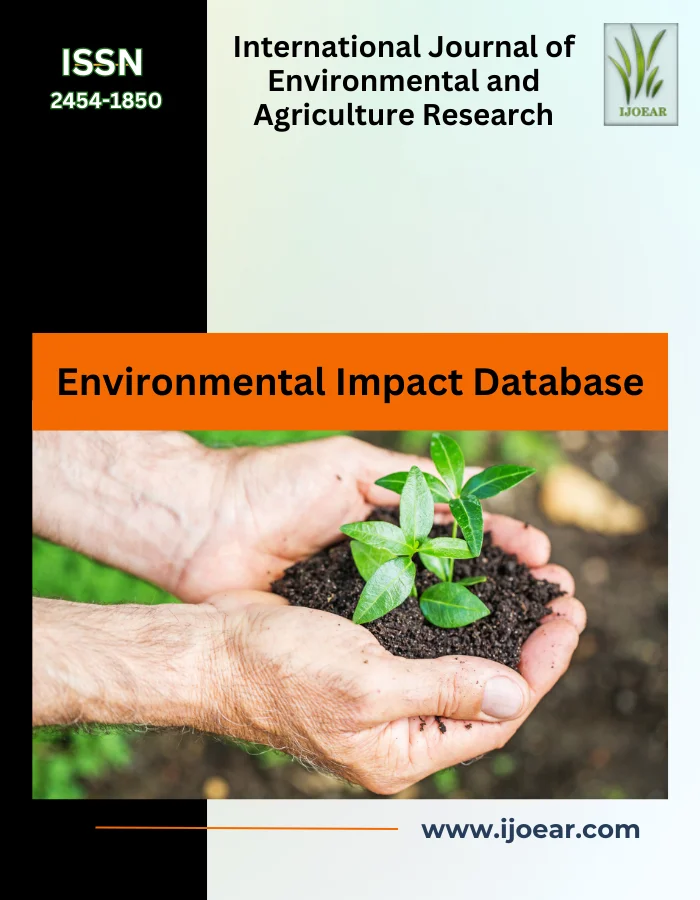
The environmental challenges we face today demand informed decisions grounded in credible research. Databases like the Environmental Impact Database (EI) serve as essential resources for scientists, policymakers, and educators working toward sustainable solutions.
The Environmental Impact Database (EI) is a comprehensive platform dedicated to cataloging information about:
The EI Database is invaluable for those exploring the complexities of environmental science because it provides:
Despite its extensive utility, the EI Database has its constraints:
For researchers aiming to publish and amplify their findings in environmental science, IJOEAR (International Journal of Environmental and Agriculture Research) offers a robust solution.
| Feature | EI Database | Agriculture Journal IJOEAR |
|---|---|---|
| Purpose | Cataloging existing research | Publishing original research |
| Access | Often subscription-based | Fully open access |
| Interactivity | Static resource | Engaged peer-review and author support |
| Research Dissemination | Not applicable | Global distribution of articles |
While the EI Database is an excellent resource for accessing environmental literature, IJOEAR provides the platform to share and expand upon these insights. Together, they form a powerful ecosystem for advancing environmental science and promoting sustainable practices.
If the EI Database has enriched your research, let IJOEAR be the next step in amplifying your contribution to environmental science. With our robust peer-review process, global reach, and open-access model, your research will make the impact it deserves.
1. What is the Environmental Impact (EI) Database in IJOEAR?
The Environmental Impact (EI) Database in IJOEAR is a curated collection of published research articles that address environmental implications in agriculture, ecology, climate change, and sustainability. It highlights studies with measurable environmental outcomes or innovations.
2. What is the purpose of maintaining an EI database in IJOEAR?
The EI database helps readers, researchers, and policymakers easily access articles that evaluate or influence environmental health, providing a central resource for evidence-based decisions and sustainable development strategies.
3. How are articles selected for inclusion in the EI database?
Articles are included based on their relevance, originality, and significance in assessing or mitigating environmental impacts. The editorial and review boards evaluate submissions for their contribution to sustainable practices and ecological research.
4. Can authors request their paper be considered for the EI Database?
Yes, authors can request consideration during submission by indicating the environmental relevance of their study. Final inclusion is subject to peer review and editorial assessment.
5. Is the EI database accessible to all readers?
Yes. The Environmental Impact Database is openly accessible through the IJOEAR website, aligning with the journal’s open access policy and promoting knowledge sharing.
6. What types of topics are commonly featured in the EI database?
Topics include:
7. How frequently is the EI database updated?
The database is updated monthly as new issues of IJOEAR are published and relevant articles are identified for inclusion.
8. How can researchers benefit from the EI database?
Researchers can use the EI database to stay updated on emerging environmental trends in agriculture, find citations for literature reviews, and identify research gaps or collaborative opportunities.
 NAAS Rating: 4.23
NAAS Rating: 4.23  October 2025 Issue
October 2025 Issue  Impact Factor: 6.69
Impact Factor: 6.69  Submit Article
Submit Article 
|
Citation Indices
|
All
|
Since 2020
|
|
Citation
|
6164
|
5117
|
|
h-index
|
31
|
29
|
|
i10-index
|
201
|
165
|
|
Acceptance Rate (By Year)
|
|
|
Year
|
Percentage
|
|
2024
|
11.09%
|
|
2023
|
15.23%
|
|
2022
|
12.81%
|
|
2021
|
10.45%
|
|
2020
|
9.6%
|
|
2019
|
14.3%
|
|
2018
|
17.65%
|
|
2017
|
16.9%
|
|
2016
|
22.9%
|
|
2015
|
26.1%
|